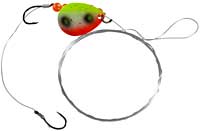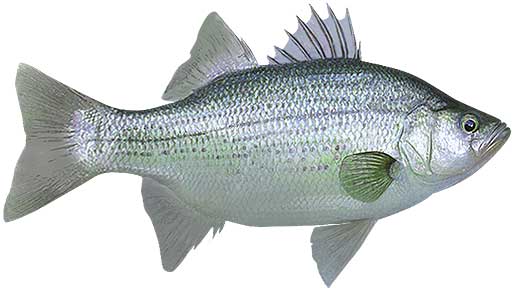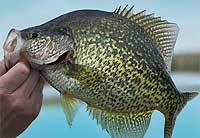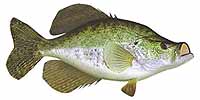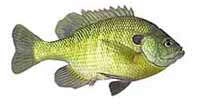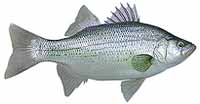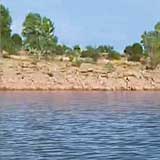Fishing Report For Sumner Lake, NM
By Rick Seaman
Last updated on .
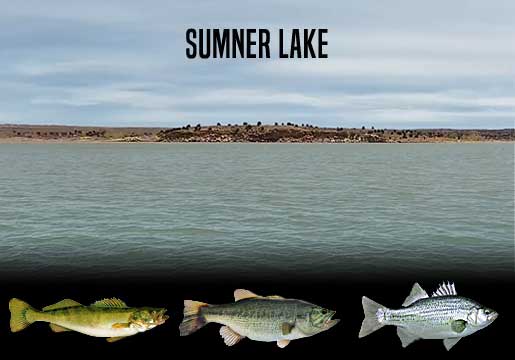
Fishing Reports
Popular Fish Species Sumner Lake, NM
Walleye
Current Report: Good
Spring and Fall are the best seasons for catching walleye, as they spend a great deal of time in shallower water.
FALL. Fall brings cooler temperatures to shallow water, drawing walleye and baitfish shallower. Jigs, swimbaits, spoons, crankbaits, jerkbaits, and spinnerbaits are all historically good for catching walleye this time of year. Early Fall finds them in 10 to 15 feet of water, to feed, and holding in 15 to 25 feet other times. Later in Fall, they move even deeper. Dragging jigs or worm harnesses with nightcrawlers or leeches, or bottom bouncers, around ledge drop-offs catches walleye fairly consistently. Watch for the bigger walleye to be slightly deeper than the majority of the school.
WINTER. This Winter fishing for walleye was pretty good through the ice. Before, during and after the ice, anglers report catching them in 15 to 25 feet of water, along creek channel edges, rocky humps and ledges. The main lake, closer to the dam, seems to hold decent numbers of walleye during the colder months. They primarily feed on small fish, staying close to the bottom. After ice-out blade baits, jigs, swimbaits, spoons, deep-diving crankbaits, and worm harness spinners, are all working while deep trolling or slow drifting.
SPRING. Early Spring brings warming water in the shallows, and draws walleye here to feed, especially rocky areas and inlet channels. Here they will spawn in 3 to 12 feet of water, once the water warms to the mid to high 40's. Afterwards, they move to 15 to 25 feet deep around shallow points, flats, shoals and ledges, nearby shore, often staying in close proximity to their spawning locations. When they move shallow, bright colored jigs, tipped with minnows or nightcrawlers typically catch them in 5 to 20 feet of water. Spinnerbaits, jerkbaits and crankbaits are also working when walleye are up shallow.
SUMMER. Water temperatures rise in Summer, and walleye fishing can be good if you focus on deep holding areas. Walleye tend to concentrate in 15 to 30 feet of water, preferring the cooler temperatures. Throughout Summer, early in the morning, and from dusk to long after dark are good times to catch walleye. At those times they move slightly shallower to feed, in low-light conditions. Night fishing is often good in Summer, as well. The rest of the time they are cruising flats and creek channel edges, where they are harder to locate and catch. When the bite is slow, grubs and nightcrawlers, fished just off the bottom are catching walleye.
Largemouth Bass
Current Report: Fair To Good
FALL. Now that Fall has arrived, bass here are moving shallow and following schools of baitfish into coves and shallow bays into 5 to 15 feet of water. Currently topwater, jerkbaits, crankbaits, and slow-rolled spinnerbaits are catching a few bass. Later in Fall, as deeper water cools, bait and bass move out to 20 or 30 feet deep on ledges, channel edges, points and humps, where flutter spoons and jigs are often good choices.
WINTER. Winter will isolate them around slightly deeper structure, flats, points and creek channels. They can be found from 20 to 40 feet deep. Here they hold, feeding less frequently, awaiting warmer water to return in Spring.
SPRING. Once water temperatures rise into the low 60's, largemouth will move from deep wintering holes, to shallower water nearby spawning areas. Vibrating jigs, jerkbaits and spinnerbaits typically get bites just away from the shoreline. At this time they are feeding aggressively and preparing for the spawn. Once water warms into the mid to high 60's, they will move into 2 to 6 feet of water, and create nests, then lay their eggs. Immediately afterwards, females move to deeper water and males remain to guard the eggs, and then the fry. After a couple weeks, the males also move to slightly deeper water. Later in Spring, deep-diving crankbaits, vibrating jigs, plastic worms and slow-rolled swimbaits, fished in 15 to 25 of water, will catch a few bass during this period.
SUMMER. Water temperatures will warm considerably in Summer. Bass will feed shallow, early and late in the day, where they are typically caught on topwater, crankbaits and swimbaits. Largemouth bass here feed on shad, small sunfish and crawfish. During the hotter parts of the day, they are being caught on points, channel edges, and ledges 25 to 40 feet deep.
White Bass
Current Report: Fair To Good
FALL. Early Fall finds white bass chasing baitfish that have moved into shallow coves and bays, from 5 to 15 feet deep. Small spinnerbaits, lipless crankbaits, curly-tail jigs, and underspins are catching good numbers of whites. Later, once the shallows cool considerably from chilly Fall temperatures, schools of white bass, along with baitfish, move deeper. They are relating to most any structure, which includes drops, humps, timber, and creek channels, in deeper water.
WINTER. Winter for white bass is a continuation of Fall patterns, except slightly deeper, around 15 to 30 feet. They are being caught on the same lures, but most are caught using a slower retrieve.
SPRING. White bass start their spawn run once the water temperature reaches the mid 50's, where they migrate to the river, inflowing creeks, or along windy points where they stay for several weeks. Early Spring is a prime time to fill the livewells with some fat white bass. Curly-tail jigs, underspins, small crankbaits, small jerkbaits, and most any lure that resembles baitfish, will catch these feeding whites. As the water temperatures continues warming, they move out of spawning areas, into slightly deeper water. Look for them following schools baitfish in 15 to 20 feet deep. Also, watch for feeding frenzies when they chase schools of bait to the surface, and the fishing can be spectacular.
SUMMER. Summer finds white bass congregating in the main lake area, following and feeding on baitfish. They are being caught on spoons, curly-tail jigs, underspins, spoons and small crankbaits, depending on the depth of the baitfish.
Fishing Video
Fish species to fish for...
Guide to fishing for largemouth bass, smallmouth bass, channel catfish, black crappie, white crappie, walleye, bluegill and white bass at Sumner Lake in New Mexico.
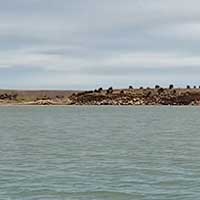
Lake Sumner Lake is a 4,500-acre with over 30 miles of shoreline, with many access points for fishing from the bank. Choose to fish for walleye, bass, white bass, crappie, sunfish and catfish, all the while enjoying the great views.
Primary fish species to catch
Click images for fishing tips and details about each species.
Today's Weather & Forecast
Public Boat Launch Ramps & Landings
Click here for boat ramps.
Fishing License
Click here for a New Mexico Fishing License.
Map - Fishing & Access
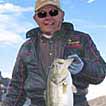
Rick Seaman is a fishing enthusiast with over five decades of fishing experience, a retired tournament fisherman, author of numerous published articles on fishing, and co-author of the book "Bass Fishing - It's not WHAT you throw, It's WHERE you throw it".
Contact Information
Sumner Lake State Park
32 Lakeview Lane
Sumner Lake, NM 88119
575 355-2541
Fishing lakes in each state
091325
Sumner Lake State Park Report
NEW MEXICO


Fishing for walleye, bass and catfish in east-central NM.





